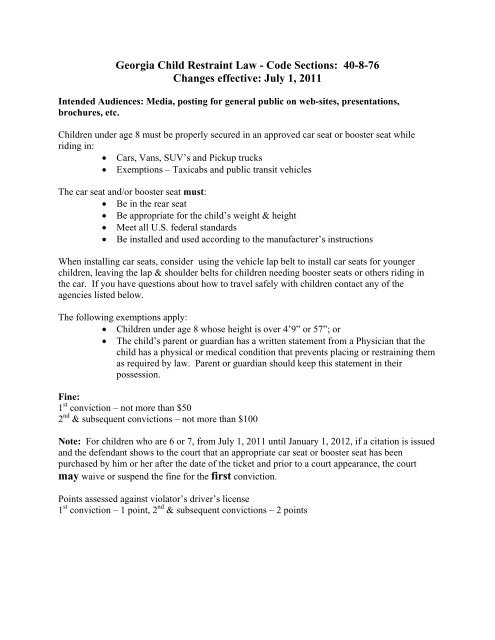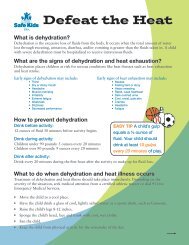Georgia Child Restraint Law - Code Sections: 40-8-76 Changes ...
Georgia Child Restraint Law - Code Sections: 40-8-76 Changes ...
Georgia Child Restraint Law - Code Sections: 40-8-76 Changes ...
You also want an ePaper? Increase the reach of your titles
YUMPU automatically turns print PDFs into web optimized ePapers that Google loves.
<strong>Georgia</strong> <strong>Child</strong> <strong>Restraint</strong> <strong>Law</strong> - <strong>Code</strong> <strong>Sections</strong>: <strong>40</strong>-8-<strong>76</strong><br />
<strong>Changes</strong> effective: July 1, 2011<br />
Intended Audiences: Media, posting for general public on web-sites, presentations,<br />
brochures, etc.<br />
<strong>Child</strong>ren under age 8 must be properly secured in an approved car seat or booster seat while<br />
riding in:<br />
• Cars, Vans, SUV’s and Pickup trucks<br />
• Exemptions – Taxicabs and public transit vehicles<br />
The car seat and/or booster seat must:<br />
• Be in the rear seat<br />
• Be appropriate for the child’s weight & height<br />
• Meet all U.S. federal standards<br />
• Be installed and used according to the manufacturer’s instructions<br />
When installing car seats, consider using the vehicle lap belt to install car seats for younger<br />
children, leaving the lap & shoulder belts for children needing booster seats or others riding in<br />
the car. If you have questions about how to travel safely with children contact any of the<br />
agencies listed below.<br />
The following exemptions apply:<br />
• <strong>Child</strong>ren under age 8 whose height is over 4’9” or 57”; or<br />
• The child’s parent or guardian has a written statement from a Physician that the<br />
child has a physical or medical condition that prevents placing or restraining them<br />
as required by law. Parent or guardian should keep this statement in their<br />
possession.<br />
Fine:<br />
1 st conviction – not more than $50<br />
2 nd & subsequent convictions – not more than $100<br />
Note: For children who are 6 or 7, from July 1, 2011 until January 1, 2012, if a citation is issued<br />
and the defendant shows to the court that an appropriate car seat or booster seat has been<br />
purchased by him or her after the date of the ticket and prior to a court appearance, the court<br />
may waive or suspend the fine for the first conviction.<br />
Points assessed against violator’s driver’s license<br />
1 st conviction – 1 point, 2 nd & subsequent convictions – 2 points
For more information:<br />
<strong>Georgia</strong>. Traffic Injury Prevention Institute (GTIPI), 800-342-9819, 678-413-4280<br />
www.ridesafegeorgia.org,<br />
Governor’s Office of Highway Safety, <strong>40</strong>4-656-6996<br />
www.gahighwaysafety.org, click on child passenger safety to find an<br />
inspection station locator<br />
Office of Injury Prevention, Div.of Public Health, <strong>40</strong>4-679-0500<br />
http://health.state.ga.us/programs/injuryprevention/occsafety.asp<br />
Safe Kids <strong>Georgia</strong>, <strong>40</strong>4-785-7221<br />
www.safekidsgeorgia.org,<br />
<strong>Child</strong> Passenger Safety Board of <strong>Georgia</strong>,<br />
www.gahighwaysafety.org/georgiacps<br />
Current car seat recommendations from the National Highway Traffic Safety<br />
Administration:<br />
• Select a car seat based on your child’s age and size, and choose a seat that fits in your<br />
vehicle and use it every time.<br />
• Always refer to your specific car seat manufacturer’s instructions; read the vehicle<br />
owner’s manual on how to install the car seat using the seat belt or LATCH system; and<br />
check height and weight limits.<br />
• To maximize safety, keep your child in the car seat for as long as possible, as long as the<br />
child fits within the manufacturer’s height and weight requirements.<br />
• Keep your child in the back seat at least through age 12.<br />
Birth – 12 months<br />
Your child under age 1 should always ride in a rear-facing car seat. There are different types of<br />
rear-facing car seats: Infant-only seats can only be used rear-facing. Convertible and 3-in-1 car<br />
seats typically have higher height and weight limits for the rear-facing position, allowing you to<br />
keep your child rear-facing for a longer period of time.<br />
1 – 3 years<br />
Keep your child rear-facing as long as possible. It’s the best way to keep him or her safe. Your<br />
child should remain in a rear-facing car seat until he or she reaches the top height or weight limit<br />
allowed by your car seat’s manufacturer. Once your child outgrows the rear-facing car seat, your<br />
child is ready to travel in a forward-facing car seat with a harness.
4 – 7 years<br />
Keep your child in a forward-facing car seat with a harness until he or she reaches the top height<br />
or weight limit allowed by your car seat’s manufacturer. Once your child outgrows the forwardfacing<br />
car seat with a harness, it’s time to travel in a booster seat, but still in the back seat.<br />
8 – 12 years<br />
Keep your child in a booster seat until he or she is big enough to fit in a seat belt properly. For a<br />
seat belt to fit properly the lap belt must lie snugly across the upper thighs, not the stomach. The<br />
shoulder belt should lie snug across the shoulder and chest and not cross the neck or face.<br />
Remember: your child should still ride in the back seat because it’s safer there.<br />
For more information on child passenger or highway safety:<br />
www.nhtsa.gov<br />
June 6, 2011









